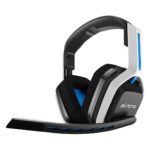For some time now, the A20 gaming headset from Logitech's subsidiary Astro Gaming has been available in its second generation, which is offered in two variants. Based on colour coding, the area of use can be visually assigned: Xbox gamers (Xbox One, Xbox One X,...
Astro
The latest reviews: Astro
The fourth generation of the gaming headset A50 from Logitech subsidiary Astro aims to impress with meaningful innovations. However, the manufacturer still offers two different versions – for Playstation or Xbox. The only difference between the two models is the colour of the printed labels...










